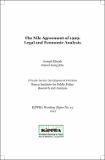Working Paper No. 19 of 2012 on The Nile Agreement of 1929: Legal and Economic Analysis
View/
Publication Date
2012Author
Type
Working Paperviews
downloads
Metadata
Show full item recordBy
Kieyah, Joseph & Kangéthe, Daniel
Abstract/
The Nile Agreement of 1929 established two substantive rules. First, it granted Egypt the exclusive property rights over the waters of the River Nile based on prior use. According to Coasian analysis, such a framework would have been efficient because, historically, it would have been difficult to define water rights in the Nile Basin, where most riparian countries were not sovereign and not clearly demarcated. Also, relative to other riparian countries, Egypt had invested more on irrigation than its counterparts. Second, the property rule was enshrined in the Agreement to legally protect Egypt’s established property rights. In retrospect, use of property rule, coupled by the fact that the Agreement did not impose Egypt with any obligation towards other riparian countries, renders the Agreement inefficient because it empowered Egypt to monopolize the utilization of the Nile waters.
Publisher
The Kenya Institute for Public Policy Research and Analysis (KIPPRA)Series
WP/19/2012;Collections
- Working Papers [34]

